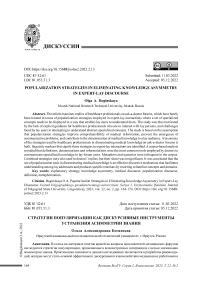Popularization strategies in eliminating knowledge asymmetry in expert-lay discourse
Автор: Boginskaya O.A.
Журнал: Вестник Волгоградского государственного университета. Серия 2: Языкознание @jvolsu-linguistics
Рубрика: Дискуссии
Статья в выпуске: 2 т.22, 2023 года.
Бесплатный доступ
The article examines replies of healthcare professionals on ask-a-doctor forums, which have barely been treated in terms of popularization strategies employed in expert-lay interactions where a set of specialized concepts needs to be displayed in a way that enables lay users to understand them. The study was thus motivated by the lack of explicit guidance for healthcare professionals who are to interact with lay persons, and challenges faced by lay users in attempting to understand abstract specialized concepts. The study is based on the assumption that popularization strategies improve comprehensibility of medical information, prevent the emergence of communicative problems, and contribute to the dissemination of medical knowledge to a lay audience. A taxonomy of the strategies used by healthcare professionals in disseminating medical knowledge on ask-a-doctor forums is built, linguistic markers that signify these strategies in expert-lay interactions are identified. A corpus-based analysis revealed that definitions, denominations and reformulations were the most common tools employed by doctors to communicate specialized knowledge to lay-forum users. Metaphors and scenarios were infrequent in the corpus. Combined strategies were also used in doctors’ replies, but their share was insignificant. It was concluded that the use of popularization tools in disseminating medical knowledge is an effective discursive mechanism that facilitates understanding among layaddressees and produces specific reactions by resorting to familiar concepts and domains.
Explanatory strategy, knowledge asymmetry, medical discourse, popularization discourse, definition, metaphorization
Короткий адрес: https://sciup.org/149143715
IDR: 149143715 | DOI: 10.15688/jvolsu2.2023.2.13
Список литературы Popularization strategies in eliminating knowledge asymmetry in expert-lay discourse
- Anesa P., 2016. The Deconstruction and Reconstruction of Legal Information in Expert-Lay Online interaction. ESP Today, vol. 4 (1), pp. 69-86.
- Anesa P., Fage-Butler A., 2015. Popularizing Biomedical Information on an Online Health Forum. Ibérica, vol. 29, pp. 105-128.
- Bagiyan A.Yu., 2017. Diskursivnye mekhanizmy populyarizacii elementov nauchnogo znaniya: kogniolingvisticheskij aspekt (na materiale anglijskogo yazyka) [Discursive Mechanisms for Popularization of Elements of Scientific Knowledge: Cognitive-Linguistic Aspect (On Material of English Language)]. Nauchnyi dialog, vol. 6, pp. 9-29. DOI: 10.24224/2227-12952017-6-9-28
- Bellés-Fortuno B., 2016. Popular Science Articles vs Scientific Articles: A Tool for Medical Education.
- Medical Discourse in Professional, Academic and Popular Settings. Language at Work. Bristol, Buffalo, Toronto, Multilingual Matters, pp. 21-36.
- Bhatia V, 1983. Simplification v. Easification - The Case of Legal Texts. Applied Linguistics, vol. 4, no. 1, pp. 42-54.
- Boginskaya O., 2020. The Simplification of Jury Instructions: Legal-Lay Interactions. ESP Today, vol. 8, no. 2, pp. 297-318.
- Bucchi M., 1996. When Scientists Turn to the Public: Alternative Routes in Science Communication. Public Understanding of Science, vol. 5, no. 2, pp. 375-394.
- Calsamiglia H., Van Dijk T.A., 2004. Popularization Discourse and Knowledge About the Genome. Discourse and Society, vol. 15, no. 4, pp. 369389. DOI: 10.1177/0957926504043705
- Ciapuscio G., 2003. Formulation and Reformulation Procedures in Verbal Interactions Between Experts and Semi-Laypersons. Discourse Studies, vol. 5, no. 2, pp. 207-233. DOI: 10.1177/ 1461445603005002004
- Fage-Butler A.M., 2013. Including Patients' Perspectives in Patient Information Leaflets: A Polyocular Approach. Fachsprache, vol. 35, no. 3, pp. 140-154. DOI: 10.24989/fs.v35i3-4.1326
- Garzone G., 2006. Perspectives on ESP and Popularization. Milano, CUEM. 230 p.
- Gotti M., 2014. Reformulation and Recontextualization in Popularization Discourse. Ibérica, vol. 27, pp. 15-34.
- Gülich E., 2003. Conversational Techniques Used in Transferring Knowledge Between Medical Experts and Non-Experts. Discourse Studies, vol. 5, no. 2, pp. 235-263. DOI: 10.1177/1461445603005002005
- Hilgartner S., 1990. The Dominant View ofPopularization: Conceptual Problems, Political Uses. Social Studies of Science, vol. 20, pp. 519-539.
- Hyland K., 2007. Applying a Gloss: Exemplifying and Reformulating in Academic Discourse. Applied Linguistics, vol. 28, no. 2, pp. 266-285. DOI: 10.1093/applin/amm011 Lakoff G., Johnson M., 2003. Metaphors We Live By.
- Chicago, University of Chicago Press. 241 p. Myers G., 2003. Discourse Studies of Scientific Popularization: Questioning the Boundaries. Discourse Studies, vol. 5/2, pp. 265-279. DOI: 10.1177/1461445603005002313
- Rezina R., 2019. Code-Switching in Ads and Its Effect in Culture. The ESP Journal, vol. 15 (1.1), pp. 168-213.
- Salerno C.M., 2019. Popularizing Copyright Law on the Institutional Platform gov. uk. PhD Thesis. Emilia. 214 p.
- Semino E., 2008. Metaphor in Discourse. Cambridge, Cambridge University Press. 347 p.
- Silletti A.M., 2015. The Role of Illustrations in Popularizing Medical Discourse. Linguae, vol. 2, pp. 65-81.
- Whitley R., Shinn T., 1985. Expository Science: Forms and Functions of Popularization. Dordrecht, Boston, Lancaster, D. Reidel Publishing Company. 275 p.


